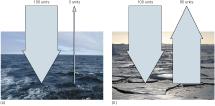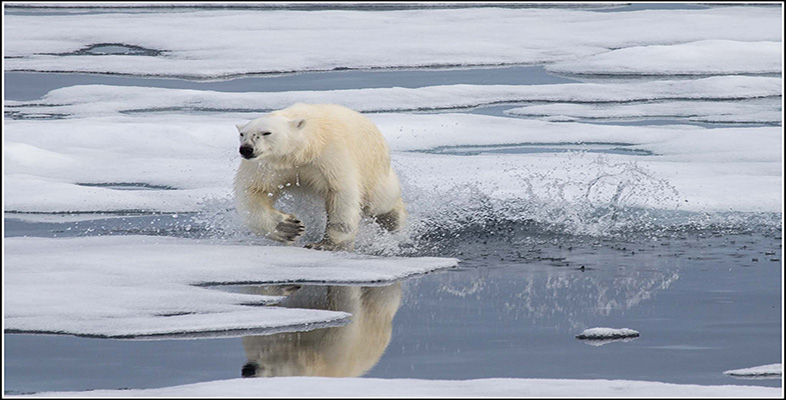4.2 The importance of albedo and heat capacity
Different materials reflect differing amounts of radiation away from them and the property that measures the amount of reflection (often expressed as a percentage) is called the albedo. When solar energy reaches the Earth’s surface, a certain amount of it is reflected straight back out into space and only the portion that is not reflected heats up what it falls on. The result is that on a warm sunny day if you put your hand on a black car and then on a white car, you will notice that the black car feels warmer. (Perhaps you could try this the next time it is sunny but be careful of car alarms!) The reason the black car is warmer is because it has a lower albedo than the white car, and so less energy is reflected away from it, so it heats up more. Table 1 shows the albedo of some typical surfaces on the Earth. For example, the surface of the ocean has an albedo of 3%, which means that 100% – 3% = 97% or almost all of the incoming energy from the Sun actually heats the water.
| Surface | Albedo (%) |
|---|---|
| ocean surface | 3 |
| conifer forest in summer | 9 |
| grassy fields | 25 |
| sea ice | 40 |
| desert sand | 40 |
| fresh snow | 80–90 |
Using Table 1 how much solar energy would be available to heat up the snow surface?
Fresh snow has an albedo of 80–90%. Assuming it is 80%, this means that only 100% – 80% = 20% is available to heat up the snow surface.
Figure 8 shows an example of this.

Question 3
If the same amount of energy reaches a desert and a conifer forest in summer, what proportion of the energy is available to heat up the material? If snow then falls to cover the conifer forest, what will be the proportion of energy available to heat up the forest?
Answer
If the same amount of energy reaches a desert and a conifer forest in summer, the amount of energy available to heat up the material will be the same for both. Table 1 shows you that a desert has an albedo of 40%, so the proportion of energy available to heat up the sand will be:
- proportion of energy = 100% – 40% = 60%
so, 60% of the incoming energy will be available to heat up the sand.
For the conifer forest in summer, Table 1 shows that a conifer forest has an albedo of 9%, so the proportion of energy available to heat up the forest will be:
- proportion of energy = 100% – 9% = 91%
If snow falls on the conifer forest, then its albedo will increase from 9% to 80–90% and so the proportion of energy available to heat up the conifer forest will be:
- proportion of energy = 100% – 80% = 20%
So only 20% of the incoming energy is now available to heat up the forest, and almost all of the incident energy is reflected away. Clearly the albedo is extremely important for the polar regions.
Once the albedo has reflected away part of the incident energy, there is one more effect to consider: different materials heat up by different amounts for the same amount of energy that they receive, as determined by their specific heat capacity. This is a measure of how much energy it takes to raise the temperature of 1 kg of a particular substance by 1 °C. A lower specific heat capacity means that it takes less energy to heat up something, and vice versa. Although the term may be unfamiliar, the concept most likely is not.
Activity 3 The effect of specific heat capacity
For this activity you will conduct a thought experiment – that is, one where you only think about what will actually happen.
Imagine a hot sunny day. On a table outside in the sunlight there is a glass containing 1 kg of water (i.e. 1 litre), a 1 kg piece of cork and a 1 kg piece of iron. Ignoring albedo effects and assuming that all three items absorb the same amount of energy from the Sun, put the three objects into order determined by how hot each will become after 1 hour. (Ignore all sources of heat except that directly received from the Sun.)
Answer
When you think about it, metal heats up very quickly, so you most likely recognised that the 1 kg of iron would be the hottest. It does not take very much heat energy to change the temperature of the iron because it has a low specific heat capacity. The other two items are harder to place, but the cork will be cooler than the iron and finally the coldest will be the water, which has the highest specific heat capacity of the three.
Water has an extremely high specific heat capacity and it takes a vast amount of energy to heat it. This fact is often used to our advantage. For example, virtually all car engines use water in their cooling systems to stop the engine overheating.
Taking into account the combined effects of the albedo and specific heat capacity, even two adjacent areas, such as a beach and the sea lapping on it, will heat up by different amounts on a sunny day. If you compare a tropical sea with the high albedo icy pictures shown in Figure 1, you can start to get an understanding of the temperature records shown in Figure 2. There is one more important feature to understand before putting the Arctic and the Antarctic into context; that is, how the energy from the Sun is distributed over the Earth.
A fraction of the solar energy received by an object is reflected away depending on its albedo. The amount an object then heats up is determined by its specific heat capacity. In the range of albedos the ocean surface has a very low value of 3%, whereas fresh snow has an albedo of 80–90%.
